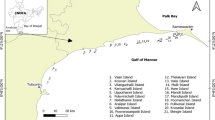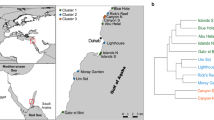Abstract
The loss of coral coverage from environmental degradation is a progressive phenomenon that occurs in coral communities around the world. However, the consequences of land use changes and its impact on the state of conservation of coral communities are not yet understood. This study compares the impact of coastal land use changes on four coral communities near rural (Isla Faro and El Zapote) and suburban (Caleta de Chon and Playa Manzanillo) sites in the states of Michoacan and Guerrero, along the central Pacific coast of Mexico. Indicators of environmental degradation in coral communities (sediment deposition, water transparency, total suspended solids, and chlorophyll concentration) show that signs of eutrophication are absent from both rural sites in Michoacan. This absence suggests that human impact is not the main cause of the observed degradation (coral Mortality Index MI = 0.85, a high death coral coverage ~42% and the lowest species richness). Instead, the 1997–1998 El Niño-Southern Oscillation (ENSO) event (the strongest in the last decade) appears to be the major factor in this coral cover decline, as it occurred in the eastern Pacific and other regions of the world. In contrast, coral communities near the suburban sites in Guerrero are well developed, and their coral coverage and species richness (up to 67.7% and 7 species, respectively) are comparable to other major coral communities in this region. Nonetheless, indicators of human-derived degradation in the Guerrero coastal zone near Caleta de Chon and Playa Manzanillo, including high sediment deposition up to 1.2 kg m−2 d−1, low water transparency <5 m, presence of filamentous algae on dead corals and a coral Mortality Index of MI ~0.6 show that human impact is beginning to affect the conservation state of these coral communities, reducing their species richness and coral coverage. Although the ENSO impact on coral communities could be more drastic than the anthropogenic impact, the current study confirms that increased land use changes and coastal erosion are causing progressive coral community degradation. Therefore, land and coastal changes must be rigorously regulated.





Similar content being viewed by others
References
Atkinson MJ, Carlson B, Crow GL (1995) Coral growth in high nutrient, low-pH seawater: a case study of corals cultured at the Waikiki aquarium, Honolulu Hawaii. Coral Reefs 14:215–233
Bell PRF (1992) Eutrophication and coral reefs. Some examples in the Great Barrier Reef lagoon. Water Res 26(5):553–568
Bellwood DR, Hughes TP, Folke C, Nystrom M (2004) Confronting the coral reef crisis. Nature 429:827–833
Berkelmans R, Oliver JK (1999) Large scale bleaching of corals on the Great Barrier Reef. Coral Reefs 18:55–60
Carballo JL, Naranjo JS, García-Gómez JC (1996) Use of marine sponges as stress indicators in marine ecosystems at Algeciras Bay (Southern Iberian Peninsula). Mar Ecol Prog Ser 135:109–122
Carballo JL, Bautista-Guerrero E, Leyte-Morales GE (2008) Boring sponges and the modeling of coral reefs in the Eastern Pacific Ocean. Mar Ecol Prog Ser 356:113–122
Carriquiry JD, Cupul-Magaña AL, Rodríguez-Zaragoza F, Medina-Rosas P (2001) Coral bleaching and mortality in the Mexican Pacific during the 1997–1998 ENSO, and predictions from a remote sensing approach. Bull Mar Sci 69:237–249
CONAGUA (1997) Resumen de la temporada de ciclones tropicales 1997. http://smn.cna.gob.mx/index.php?option=com_content&view=article&id=38&Itemid=46 (Accessed 17 September 2007)
Cortes J (1990) The coral reefs of Golfo Dulce, Costa Rica: distribution and community structure. Atoll Res Bull 344:1–37
Cortes J (1997) Biology and geology of eastern Pacific coral reefs. Coral Reefs 16:s39–s46
Cortes J, Risk MJ (1985) A reef under siltation stress: Cahuita, Costa Rica. Bull Mar Sci 36(2):339–356
Diaz-Pulido G, McCook LJ, Dove S et al (2009) Doom and bloom on a resilient reef: climate change, algal overgrowth and coral recovery. PLoS ONE 4(4):e5239. doi:10.1371/journal.pone.0005239
Dodge RE, Aller RC, Thompson J (1974) Coral growth related to resuspension of bottom sediments. Nature 247:574–577
Dustan P, Dobson E, Nelson G (2001) Landsat thematic mapper: detection of shifts in community composition of coral reefs. Conserv Biol 15(4):892–902
Edinger EN, Jompa J, Limmon GV, Widjatmoko W, Risk MJ (1998) Reef degradation and coral biodiversity in Indonesia: effects of land-based pollution, destructive fishing practices and changes over time. Mar Pollut Bull 36(8):617–630
Edinger EN, Limmon GV, Jompa J, Widjatmoko W, Heikoop JM, Risk MJ (2000) Normal coral growth rates on dying reefs: are coral growth rates good indicators of reef health? Mar Pollut Bull 40(5):404–425
Fabricius KE (2005) Effects of terrestrial runoff on the ecology of coral and coral reefs: review and synthesis. Mar Pollut Bull 50:125–146
Fabricius KE, De’ath G, McCook L, Turak E, Williams DM (2005) Changes in algal, coral and fish assemblages along water quality gradients on the inshore Great Barrier Reef. Mar Pollut Bull 51:384–398
FIBAZI (2005) Plan director de desarrollo urbano de Ixtapa-Zihuatanejo
FONATUR (2006) Plan regional para el desarrollo turístico integral de la costa de Michoacán
Fonseca AC, Dean HK, Cortes J (2005) Non-colonial macroborers as indicators of coral reef status in the south Pacific of Costa Rica. Int J Trop Biol 54(1):101–115
García-Martínez M (2003) La formación arrecifal de Caleta de Chon, Zihuatanejo, Guerrero, Mexico: una aproximación desde la ecología del paisaje. Dissertation, Universidad Nacional Autónoma de México
Glynn PW (1988) El Niño warming, coral mortality and reef framework destruction by echinoid bioerosion in the eastern Pacific. Galaxea 7:129–160
Glynn PW (1994) State of coral reefs in the Galápagos Islands: natural versus anthropogenic impacts. Mar Pollut Bull 29:131–140
Glynn PW (2003) Coral communities and coral reefs of Ecuador. In: Cortes J (ed) Latin American coral reefs. Elsevier, Amsterdam, pp 449–472
Glynn PW, Lirman D, Baker AC, Leyte-Morales GE (1998) First documented hurricane strikes on eastern Pacific coral reefs reveal only slight damage. Coral Reefs 17:368
Gómez ED, Aliño PM, Yap HT, Licuanan WY (1994) A review of the status of Philippine reefs. Mar Pollut Bull 29:62–68
Goreau T, McClanahan T, Hayes R, Strong A (2000) Conservation of coral reefs after the 1998 global bleaching event. Conserv Biol 14(1):5–15
Granja-Fernández MR, López-Pérez RA (2008) Sedimentación en comunidades arrecifales de Bahías de Huatulco, Oaxaca, Mexico. Rev Biol Trop 56:1179–1187
Guadarrama-García E (2008) Composición y cuantificación de la comunidad de organismos que erosionan el coral Porites lobata (Dana 1846) (Cnidaria: Anthozoa) en la Isla Isabel (Nayarit). Dissertation, Instituto Tecnológico de Bahía de Banderas
Hawkins JP, Roberts CM, Van’t Hof T et al (1999) Effects of recreational scuba diving on Caribbean coral and fish communities. Conserv Biol 13(4):888–897
Heikoop JM, Risk MJ, Lazier AV et al (2000) Nitrogen-15 signals of anthropogenic nutrient loading in reef corals. Mar Pollut Bull 40(7):628–636
Hoegh-Guldberg O, Mumby PJ, Hooten AJ et al (2007) Coral reefs under rapid climate change and ocean acidification. Science 318:1737–1742
Holmes KE, Edinger EN, Hariyadi, Limmon GV, Risk MJ (2000) Bioerosion of live massive corals and branching coral rubble on Indonesian coral reefs. Mar Pollut Bull 40(7):606–617
Larcombe P, Woolfe KJ (1999) Increased sediment supply to the Great Barrier Reef will not increase sediment accumulation at most coral reefs. Coral Reefs 18:163–169
López-Pérez RA, Hernández-Ballesteros LM (2004) Coral community structure and dynamics in the Huatulco area, western Mexico. Bull Mar Sci 75(3):453–472
López-Pérez RA, Mora-Pérez MG, Leyte-Morales GE (2007) Coral (Anthozoa: Scleractinia) recruitment at Bahías de Huatulco, western Mexico: implications for coral community structure and dynamics. Pac Sci 61(3):355–369
MacDonald IA, Perry CT (2003) Biological degradation of coral framework in a turbid lagoon environment, Discovery Bay, north Jamaica. Coral Reefs 22:523–535
McClanahan TR, Cokos BA, Sala E (2002) Algal growth and species composition under experimental control of herbivory, phosphorous and coral abundance in Glovers Reef, Belize. Mar Pollut Bull 44:441–451
Nava HH (2008) Dinámica, estructura de la comunidad y procesos de bioerosión de las esponjas perforadoras en algunas comunidades coralinas de Nayarit, Mexico. Ph.D. Dissertation, Universidad Nacional Autónoma de México
Ochoa-López E, Reyes-Bonilla H, Ketchum-Mejia J (1998) Daños por sedimentación a las comunidades coralinas del sur de la Isla Socorro, Archipiélago de Revillagigedo, Mexico. Cienc Mar 24(2):233–240
Oseguera-Cruz JM (2004) Estructura comunitaria de corales hermatípicos en Caleta de Chon, Zihuatanejo, Guerreo, Mexico. Dissertation, Universidad Nacional Autónoma de México
Pastorok RA, Bilyard GR (1985) Effects of sewage pollution on coral-reef communities. Mar Ecol Prog Ser 21:175–189
Pineda-Páez A (2008) Descripción de los corales hermatípicos (Hexacoralarios) del área arrecifal, del Zapote de Madero y el Faro de Bucerías, municipios de Aquila, Michoacán. Dissertation, Universidad Michoacana de San Nicolás de Hidalgo
Reyes-Bonilla H, Carriquiry JD, Leyte-Morales GE, Cupul-Magaña AL (2002) Effects of the El Niño-Southern Oscillation ant the anti-El Niño event (1997–1999) on coral reefs of the western coast of Mexico. Coral Reefs 21:368–372
Reyes-Bonilla H, Calderón-Aguilera LE, Cruz-Piñón G et al (2005) Atlas de los corales pétreos (Anthozoa: Scleractinia) del Pacífico Mexicano. CICESE, CONABIO, CONACYT, DBM/UABCS, CUC/UdeG, UMar, México DF
Rogers CS (1990) Responses of coral reefs and reef organisms to sedimentation. Mar Ecol Prog Ser 62:185–202
Rogers CS, Garrison G, Grober R, Hillis ZM, Franke MA (1994) Coral reef monitoring manual for the Caribbean and western Atlantic. US National Park Service, St. John
Rohan A (2000) Coral bleaching and mortality in three Indian regions during an El Niño Sourthern oscillation even. Curr Sci 79(12):1723–1729
Ryan KE, Walsh JP, Corbett DR, Winter A (2008) A record of recent change in terrestrial sedimentation in a coral-reef environment, La Parguera, Puerto Rico: a response to coastal development? Mar Pollut Bull 56:1177–1183
Sheppard CRC, Spalding M, Bradshaw C, Wilson S (2002) Erosion vs. recovery of coral reefs after 1998 El Niño: Chagos reefs, Indian Ocean. Ambio 31(1):40–48
Sokal RR, Rohlf FJ (1981) Biometry. The principles and practice of statistics in biological research, 2nd edn. Freeman WH and Co., New York
Strong AE, Barrientos CS, Duda C, Sapper J (1997) Improved satellite techniques for monitoring coral reef bleaching. Proc 8th Int Coral Reef Symp 2:1495–1498
Tratalos JA, Austin TJ (2001) Impacts of recreational scuba diving on coral communities of the Caribbean island of Grand Cayman. Biol Conserv 102:67–75
Van Woesik R (1992) Ecology of coral communities on continental islands in the southern section of the Great Barrier Reef, Australia. Ph.D, Dissertation, James Cook University
Venkataraman K (2006) Coral reefs in India. NBA Bull 4:1–70
Victoria-Salazar I (2007) Caracterización de la comunidad de corales escleractinios de playa las Gatas, Zihuatanejo, Guerrero, México. Fisiografía y estructura comunitaria. Dissertation, Universidad Nacional Autónoma de México
Zakai D, Levi O, Chadwick-Furman NE (2000) Experimental fragmentation reduces sexual reproductive output by the reef building coral Pocillopora damicornis. Coral Reefs 19:185–188
Zamorano P, Leyte-Morales GE (2005) Population density of four species of sea urchin (Echinodermata: Echinoidea) at La Entrega Reef, Oaxaca. Oceanides 20(12):65–72
Acknowledgments
Special thanks go to Dr. Tuyeni Mwampamba for a thorough review and discussion, and to Dr. Michael McCall and Dr. Alejandro Velazquez for their valuable comments that improved this manuscript. José Antonio Navarrete assisted with GIS database management and mapping. Thanks go to Violeta Rangel and Ana Vergara for field assistance. Julien Neméry and Amílcar Cupul-Magaña kindly provided logistic support. Special acknowledgements go to the local community at Faro de Bucerías, state of Michoacan and at Zihuatanejo and Barra de Potosi, Guerrero. We are grateful for comments by editor Dr. James W. LaMoreaux and an anonymous reviewer that helped improved this manuscript. This research was partially funded by SEMARNAT-CONACYT grant No. 107902 and Universidad Nacional Autónoma de México-DGAPA granted to M. Teresa Ramírez-Herrera.
Author information
Authors and Affiliations
Corresponding author
Rights and permissions
About this article
Cite this article
Nava, H., Ramírez-Herrera, M.T. Land use changes and impact on coral communities along the central Pacific coast of Mexico. Environ Earth Sci 65, 1095–1104 (2012). https://doi.org/10.1007/s12665-011-1359-3
Received:
Accepted:
Published:
Issue Date:
DOI: https://doi.org/10.1007/s12665-011-1359-3




